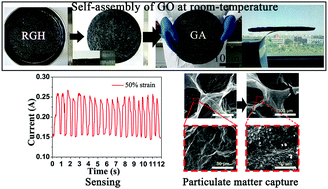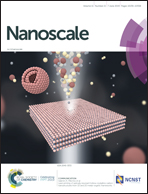Large-area superelastic graphene aerogels based on a room-temperature reduction self-assembly strategy for sensing and particulate matter (PM2.5 and PM10) capture†
Abstract
Graphene aerogels are emerging low density and superelasticity macroscopic porous materials with various applications. However, it still remains a challenge to develop a versatile strategy under ambient conditions for fabricating large-area, high-performance graphene aerogels, which is crucial for their practical applications. Here, we report a novel room-temperature reduction self-assembly (RTRS) strategy to fabricate large-area graphene aerogels under ambient conditions. The strategy is based on using unique hydrazine hydrates as reducing agents to generate stable microbubbles beneficial for the formation of macroporous graphene hydrogels. Interestingly, the resultant hydrogel followed by a simple pre-freeze treatment can be naturally dried into graphene aerogels without noticeable volume shrinkage or structure cracking. Benefiting from the mild conditions, a large-area graphene aerogel with a diameter of up to 27 cm was prepared as an example. The as-formed aerogels exhibit a stable honeycomb-like coarse-pores structure, a low density of 3.6 mg cm−3 and superelasticity (rapidly recoverable from 95% compression) which are suitable for pressure/strain sensors. Moreover, the aerogel exhibits superior particulate matter adsorption efficiency (PM2.5: 93.7%, PM10: 96.2%) and good recycling ability. Importantly, the preparation process is cost-effective and easily scalable without the need for any special drying techniques and heating processes, which provides an ideal platform for mass production of graphene aerogels toward practical applications.



 Please wait while we load your content...
Please wait while we load your content...